In today’s fast-paced world, where fatigue, digestive discomfort, and dietary confusion run rampant, many are turning to smarter nutrition strategies to reclaim control over their energy levels and well-being. A thoughtfully crafted high fiber diet meal plan can do just that—offering sustainable energy while supporting a balanced gut microbiome, improved digestion, and long-term health. Rooted in both ancient dietary wisdom and cutting-edge nutritional science, high fiber eating isn’t just about adding bran to your breakfast; it’s a holistic approach that transforms how your body functions from the inside out. When thoughtfully implemented, such a plan fuels consistent vitality throughout the day, supports metabolic health, and fosters a gut environment teeming with beneficial microbes, essential for everything from immune resilience to mental clarity.
You may also like: 10 Essential Tips on Choosing Healthy Food for Ladies to Boost Energy and Wellness
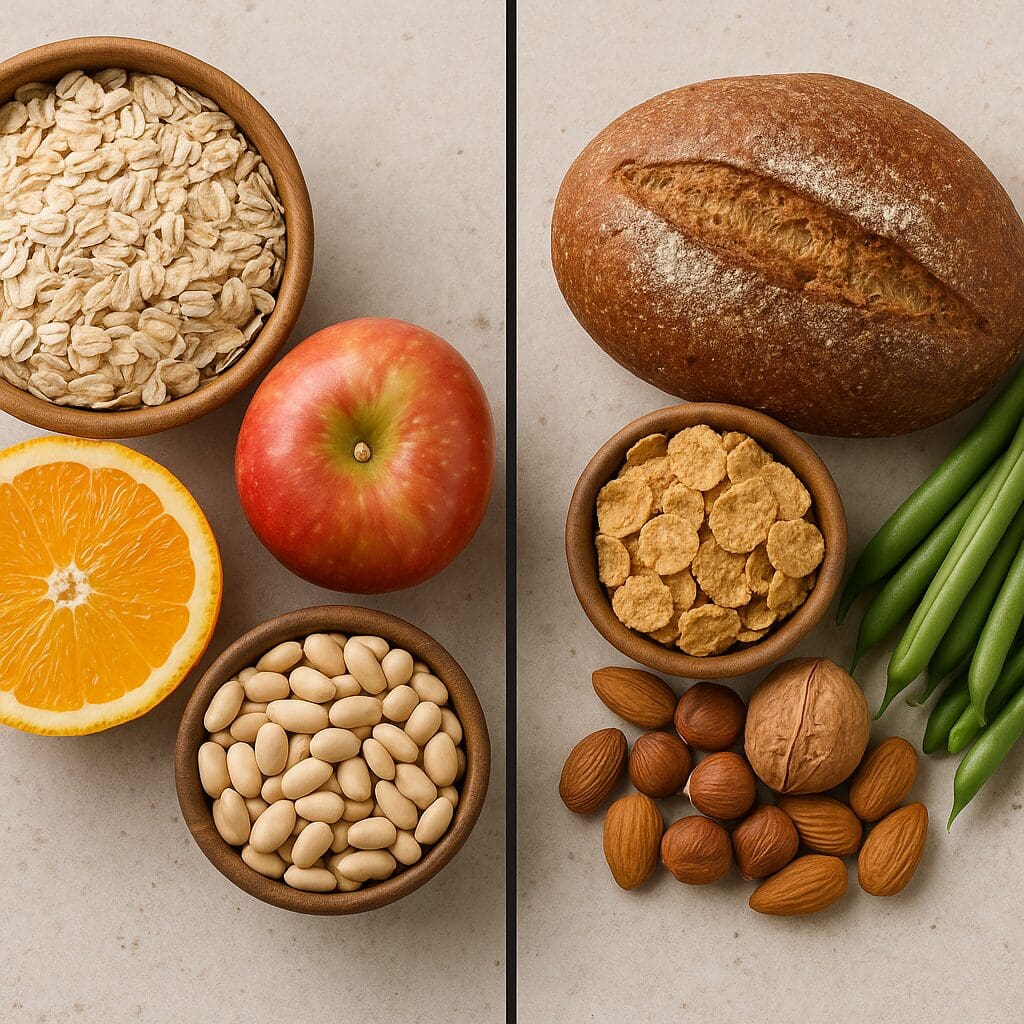
Understanding Fiber: Soluble vs. Insoluble and Why It Matters
Fiber is a form of carbohydrate that resists digestion in the small intestine and reaches the colon intact. However, not all fibers are created equal. Soluble fiber dissolves in water and forms a gel-like substance in the gut, which slows digestion, stabilizes blood sugar levels, and helps lower LDL cholesterol. Oats, legumes, psyllium husk, apples, and citrus fruits are rich in this form. Insoluble fiber, by contrast, doesn’t dissolve but adds bulk to stool and accelerates intestinal transit time—crucial for preventing constipation and promoting bowel regularity. You’ll find insoluble fiber in whole wheat, corn bran, nuts, seeds, and vegetables like cauliflower or green beans.
Both types of fiber are vital for balanced nutrition and should be incorporated into any high fiber diet meal plan. Together, they help maintain satiety, support glycemic control, and encourage the flourishing of diverse gut microbiota. Soluble fiber often plays a starring role in managing heart health, while insoluble fiber is your ally in digestive rhythm and detoxification. Understanding their roles allows for a strategic approach, customizing intake according to health goals like managing diabetes, cholesterol, or constipation. Even more compelling, emerging research links dietary fiber—especially the soluble variety—to enhanced mental health outcomes, likely due to its impact on short-chain fatty acid (SCFA) production and the gut-brain axis.
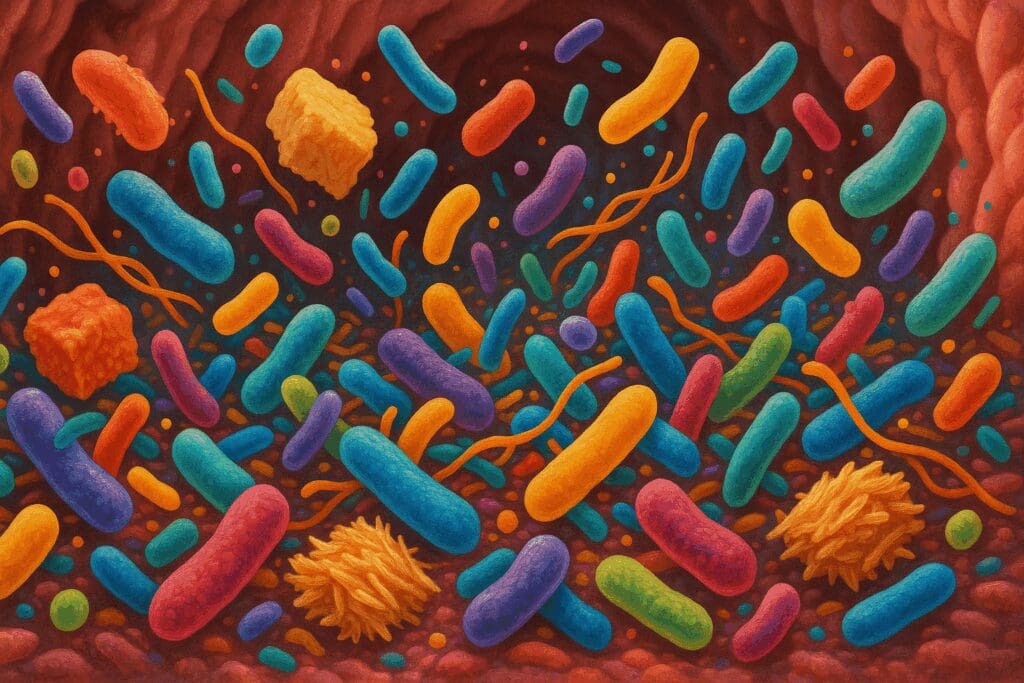
The Gut Microbiome Connection: Fiber as Prebiotic Fuel
Dietary fiber is not simply an inert filler—it acts as a potent prebiotic, feeding the trillions of beneficial bacteria that reside in our colon. This microbial community plays an essential role in immunity, inflammation regulation, mental health, and even nutrient synthesis. When fiber reaches the colon, it is fermented by specific bacterial strains into SCFAs like butyrate, acetate, and propionate. These SCFAs nourish colonocytes (the cells lining your colon), maintain intestinal barrier integrity, and reduce systemic inflammation. A well-structured high fiber diet plan ensures you regularly consume diverse plant fibers to support microbial diversity, which is a critical marker of gut health.
Notably, different types of fiber nourish different bacterial species. Inulin, for example, encourages the growth of Bifidobacteria, while resistant starch fuels butyrate-producing bacteria like Faecalibacterium prausnitzii. Including a range of fibers from whole grains, legumes, fruits, and vegetables enhances the richness and resilience of the microbiome. This, in turn, strengthens the body’s resistance to infections, reduces the risk of chronic disease, and may even moderate mood disorders such as anxiety and depression. The benefits of fiber extend far beyond the colon, positioning it as a cornerstone of holistic health.
High Fiber Diet Meal Plan Essentials: Building Blocks for Energy and Balance
Creating a high fiber diet meal plan is more than hitting a daily number; it’s about choosing fiber-rich foods that deliver comprehensive nutrition and energize your body in a sustained, non-jittery way. Whole foods such as oats, barley, lentils, chickpeas, sweet potatoes, avocados, and berries provide not only fiber but also critical micronutrients like magnesium, potassium, B vitamins, and polyphenols. A strong foundation includes at least 25–30 grams of fiber per day, though some individuals thrive on as much as 40–50 grams, particularly when building up gradually and maintaining hydration.
Each meal should strike a balance between fiber, protein, and healthy fats to minimize blood sugar spikes and maximize nutrient absorption. For breakfast, think steel-cut oats topped with flaxseeds and raspberries; for lunch, a quinoa bowl loaded with chickpeas, roasted vegetables, and a tahini dressing; for dinner, a lentil stew paired with leafy greens and a side of fermented sauerkraut for an added probiotic punch. Snacks should also contribute meaningfully—consider chia pudding, hummus with raw vegetables, or roasted edamame.
Hydration is essential when adopting a high fiber eating pattern. Fiber attracts water, and without sufficient fluid intake, it can lead to bloating or sluggish digestion. Herbal teas, infused waters, or simply drinking enough plain water throughout the day ensures optimal fiber function and supports peristalsis, the muscle contractions that move food through the gut.
Strategic Meal Timing and Energy Distribution with High Fiber Foods
When it comes to sustaining energy throughout the day, the timing of high fiber intake plays a crucial role. Consuming a fiber-rich breakfast helps blunt the cortisol-driven blood sugar spike that naturally occurs in the early morning hours. A hearty, fiber-forward start not only delays hunger until lunchtime but also enhances focus and productivity during the most cognitively demanding part of the day. Midday meals should continue this trajectory with complex carbs and legumes, offering a second wave of sustained energy that keeps you clear-headed and productive.
Dinner in a high fiber diet meal plan should be thoughtfully composed to ease digestion while preparing the body for restorative sleep. While fiber is essential, the evening meal should focus more on soluble varieties—such as lentils or cooked vegetables—which are easier to digest than raw, fibrous foods like kale or cabbage. Including a moderate amount of fat and a smaller portion of slow-digesting carbs helps maintain overnight satiety without overburdening the digestive system.
Snacking strategically between meals with fiber-rich options—especially those containing protein and healthy fats—can help smooth out energy dips without compromising insulin sensitivity. Examples include apple slices with almond butter or a handful of walnuts with dried figs. This nuanced approach to meal timing not only preserves stable blood sugar but also fosters circadian rhythm alignment, supporting deeper sleep and metabolic health.
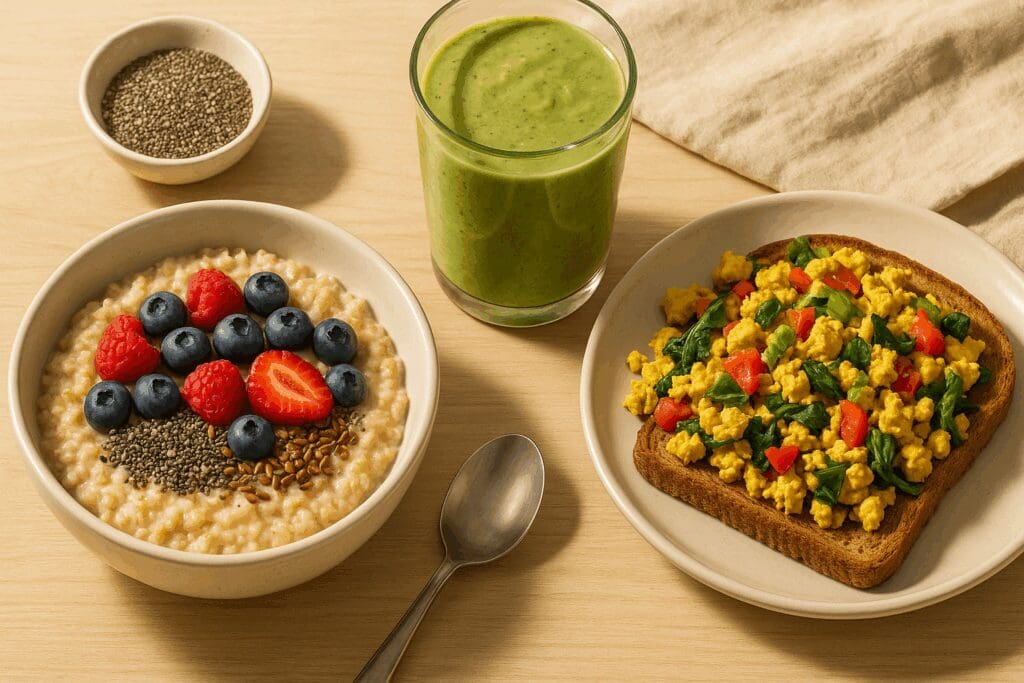
Morning Fuel: Fiber-Rich Breakfasts to Jumpstart Digestion and Focus
A well-constructed breakfast sets the tone for the day, particularly in a high fiber diet plan where morning meals must provide both digestive stimulation and cognitive clarity. Oats—whether steel-cut, rolled, or overnight—serve as an exceptional base due to their beta-glucan content, a form of soluble fiber that has been shown to reduce cholesterol and support immune function. Pairing oats with chia seeds, pumpkin seeds, and berries not only increases fiber but also adds essential omega-3s, magnesium, and antioxidants.
Smoothies can also be transformed into high-fiber powerhouses. Blending spinach, frozen banana, flaxseeds, oat milk, and protein powder creates a portable and digestible morning fuel source. Adding half an avocado lends creaminess while boosting fiber and potassium. For those preferring savory starts, a veggie-packed tofu scramble with sautéed spinach, bell peppers, and black beans on a slice of sprouted whole grain toast delivers both insoluble and soluble fiber, along with plant-based protein and iron.
Importantly, avoid starting your day with highly refined grains or sugary cereals, which can cause an initial blood sugar spike followed by a crash mid-morning. Instead, anchor your breakfast with at least 8–10 grams of fiber, ideally combining both soluble and insoluble sources. This promotes bowel regularity and primes your metabolism for sustained output throughout the day.
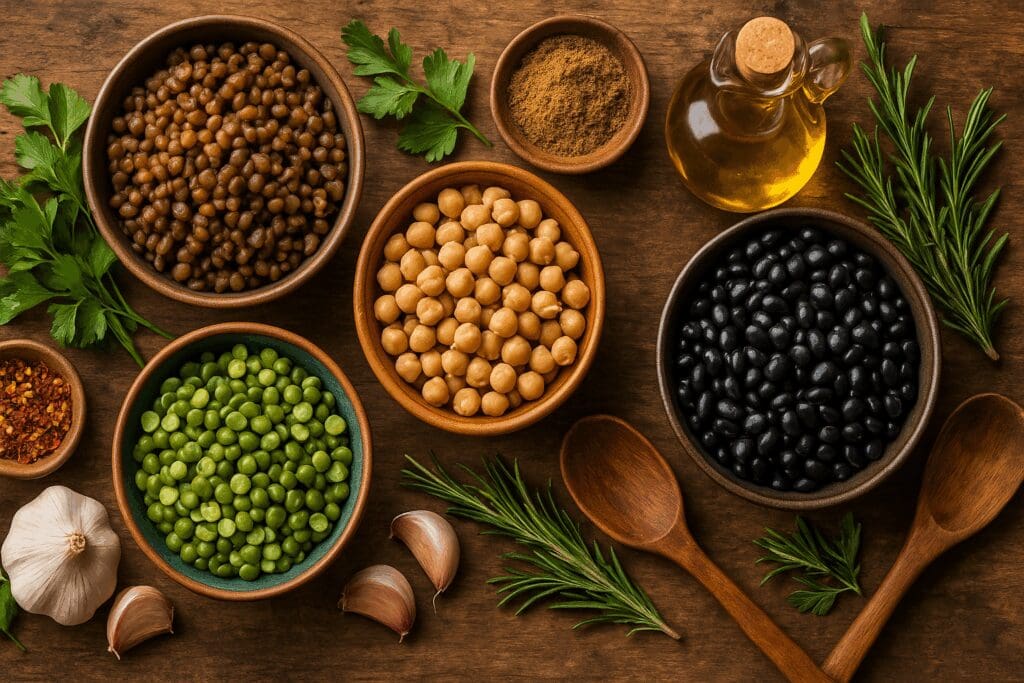
The Power of Pulses: Legumes in a High Fiber Diet Meal Plan
No high fiber diet plan is complete without a heavy emphasis on legumes, which deliver unmatched fiber density along with protein, iron, folate, and other micronutrients essential for energy metabolism. Lentils, black beans, chickpeas, and split peas contain both soluble and insoluble fibers, making them particularly effective at stabilizing blood sugar and supporting healthy gut transit. One cup of cooked lentils, for example, boasts around 15 grams of fiber—more than half the recommended daily intake.
Incorporating legumes into lunch and dinner meals can take many forms: think Moroccan lentil soup with turmeric and garlic; a warm black bean and quinoa salad with cumin, lime, and cilantro; or roasted chickpeas tossed with olive oil and paprika as a crunchy salad topper or snack. These foods are not only nutritionally robust but also highly affordable and shelf-stable, making them excellent staples for meal prepping.
To optimize digestion, especially for those new to legumes, it’s advisable to soak dried varieties overnight and rinse canned beans thoroughly to reduce oligosaccharides that may cause gas. Over time, your microbiome will adapt, increasing your tolerance and maximizing the benefits of these plant-based powerhouses. Including legumes regularly is also linked to longevity and reduced risk of metabolic diseases—evidence that elevates them from side dish to mainstay in any high fiber strategy.
High Fiber Diet Meal Plan Strategies for Lunch and Dinner Satisfaction
Midday and evening meals offer prime opportunities to incorporate hearty, fiber-dense ingredients that provide lasting satiety and nourishment. A successful high fiber diet meal plan balances legumes, whole grains, and vegetables in creative, flavorful ways that prevent boredom and maximize compliance. For lunch, grain bowls featuring brown rice, bulgur, or farro form a versatile base, ready to be topped with roasted vegetables, edamame, sauerkraut, tahini, or a scoop of hummus. These meals deliver substantial fiber while also packing an array of vitamins, minerals, and phytonutrients that support immune health and energy metabolism.
Dinner should follow similar principles but with greater emphasis on digestibility and preparation for rest. Cooked vegetables are often more suitable in the evening as they are easier on the digestive tract. A bowl of red lentil curry over basmati rice with steamed kale and toasted pumpkin seeds is a warming, nourishing option that brings over 20 grams of fiber while also supplying iron and zinc. For variety, experiment with fiber-rich soups like white bean and escarole, or stuffed bell peppers with quinoa, black beans, and onions. Integrating herbs and spices such as ginger, fennel, cumin, and coriander not only boosts flavor but also aids digestion and balances gut flora.
Adding fermented or pickled vegetables to dinner plates—such as kimchi or lacto-fermented carrots—provides a symbiotic effect, as the prebiotic fiber feeds beneficial microbes while the probiotics reinforce gut health directly. The key is to assemble meals that are visually appealing, texturally satisfying, and culturally diverse, ensuring that fiber-rich eating feels indulgent, not restrictive.
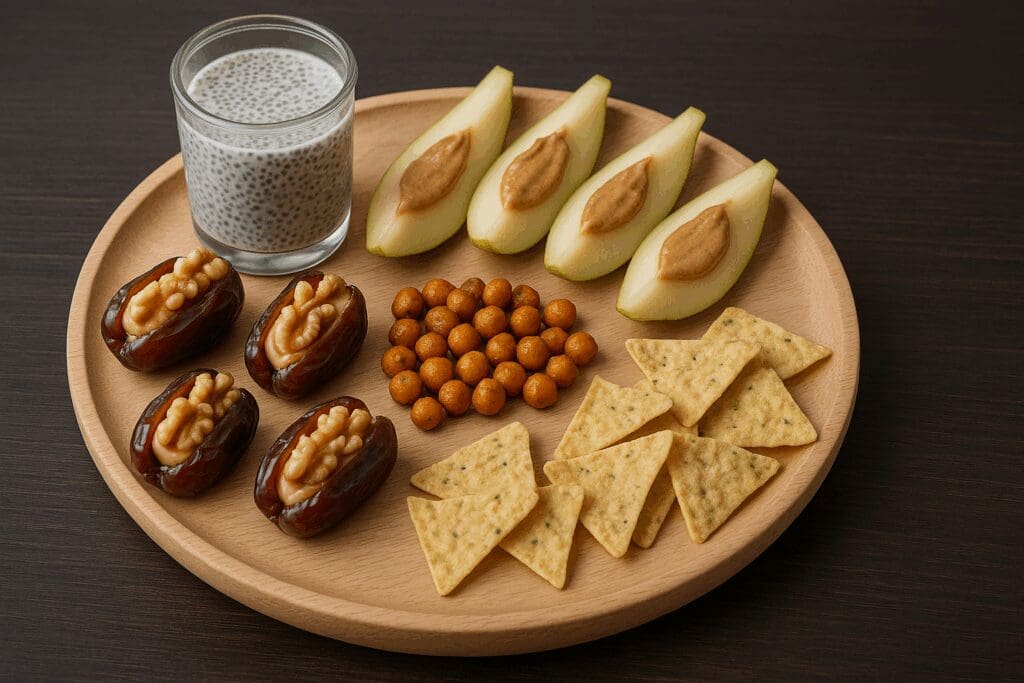
Rethinking Snacks: Creative Fiber-Focused Energy Boosters
Snacking is often where high fiber goals go awry, with people turning to ultra-processed options low in fiber and high in empty calories. But with a little planning, snacks can contribute significantly to your fiber totals and keep energy levels steady throughout the day. A well-crafted high fiber diet meal plan includes snack options that provide at least 4–6 grams of fiber while also supplying protein or healthy fats to moderate glycemic response and extend satiety.
Consider a pear with almond butter, which delivers both soluble and insoluble fiber along with monounsaturated fats. Chia pudding made with unsweetened almond milk, vanilla, and cinnamon offers a powerful dose of omega-3s and gel-forming fiber that supports bowel regularity. Roasted chickpeas or seasoned lentil chips can satisfy savory cravings while adding crunch and prebiotic fiber. For those needing a sweet fix, dates stuffed with peanut butter and rolled in crushed walnuts make a nutrient-dense, energy-sustaining bite.
Even beverages can contribute: adding ground flaxseed or psyllium husk to smoothies or soups boosts the fiber count while supporting gut transit. The key is to move away from the idea of snacks as filler and toward snacks as functional contributors to your overall dietary goals.

High Fiber Diet Plan for Active Lifestyles and Athletic Performance
Athletes and fitness enthusiasts often underestimate the role of fiber in performance nutrition. While protein and carbs take center stage, fiber plays an essential supporting role by regulating blood glucose, enhancing nutrient absorption, and promoting efficient elimination of metabolic waste. A high fiber diet plan tailored to active individuals ensures that fiber intake supports rather than impedes performance, focusing on timing, type, and pairing with other macronutrients.
Pre-workout meals should prioritize lower fiber to minimize digestive discomfort during activity, but post-workout recovery can incorporate fiber-rich carbohydrates that replenish glycogen and support satiety. A post-exercise bowl of quinoa with lentils, roasted beets, arugula, and tahini dressing not only restores energy but also provides antioxidants and prebiotic fiber that reduce inflammation and accelerate recovery.
Fiber also enhances hydration by helping retain fluid in the intestines, which is crucial for athletes training in hot or demanding conditions. Additionally, a fiber-rich diet helps regulate hormone metabolism by facilitating the excretion of excess estrogen and cortisol—an often overlooked benefit for female athletes or those undergoing intensive endurance training.
The Role of Fermented and Resistant Fibers in Gut Healing
Beyond the commonly discussed soluble and insoluble varieties, certain types of fiber—such as resistant starch and fermentable oligosaccharides—play a uniquely healing role in gut health. Resistant starch escapes digestion and becomes fuel for beneficial microbes in the colon, leading to the production of butyrate, which has anti-inflammatory and cancer-protective properties. Foods high in resistant starch include cooked and cooled potatoes, green bananas, and legumes.
Fermentable fibers like fructooligosaccharides (FOS) and galactooligosaccharides (GOS) are abundant in foods like garlic, onions, leeks, and asparagus. These fibers selectively feed beneficial bacterial strains and may enhance immune resilience. Integrating these specialty fibers into your high fiber diet plan enhances diversity within the gut microbiome and strengthens the gut lining, which is essential for individuals with irritable bowel syndrome, leaky gut, or autoimmune conditions.
For those with sensitive digestion, it’s crucial to increase these fibers gradually and consider combining them with gut-soothing nutrients like collagen, glutamine, and fermented foods to prevent symptom flare-ups. Over time, the gut becomes more resilient, better able to process a variety of fibers, and more capable of extracting nutrients from food with minimal discomfort.
Overcoming Common Challenges on a High Fiber Diet Plan
Transitioning to a high fiber diet plan often comes with temporary discomforts such as bloating, gas, or irregular bowel movements. These are typically signs of microbiome adaptation and can be minimized by increasing fiber slowly, one meal at a time. It’s also important to match fiber intake with adequate water consumption—at least eight glasses per day—to help fiber swell and move efficiently through the intestines.
For those struggling with chronic bloating or IBS symptoms, a modified fiber approach may be necessary. Low-FODMAP options can allow fiber intake to continue while reducing fermentable carbohydrate load. Cooked rather than raw vegetables, de-skinned legumes, and small servings of high-fiber fruits can serve as bridges to greater tolerance over time.
Another common barrier is the perception that fiber-rich foods are bland or require extensive preparation. However, with the abundance of fiber-rich ready-made products like sprouted breads, frozen mixed vegetables, canned beans, and pre-cooked grains, it is entirely possible to assemble quick, delicious meals in under 15 minutes. Education and experimentation are key—trying new spices, international recipes, and cooking methods can keep fiber-rich eating enjoyable and sustainable.
High Fiber Diet Meal Plan Examples: A Day of Sustainable Eating
To make the concept more tangible, consider the following sample day on a high fiber diet meal plan. For breakfast, a bowl of steel-cut oats simmered in almond milk with ground flaxseed, blueberries, cinnamon, and chopped walnuts provides around 12 grams of fiber. Mid-morning, snack on a green smoothie with spinach, avocado, chia seeds, banana, and unsweetened plant milk for another 8 grams.
Lunch might be a Mediterranean-style grain bowl with farro, cherry tomatoes, artichoke hearts, chickpeas, arugula, and a lemon-olive oil dressing—contributing 15 grams of fiber. For an afternoon snack, reach for sliced apple and almond butter or roasted lentils, adding 5–7 more grams. Dinner could be a lentil and sweet potato curry with collard greens and a side of brown rice, finishing the day with over 40 grams of total fiber.
These examples highlight the power of layering diverse fiber sources throughout the day. Rather than relying on one “superfood,” success lies in the cumulative effect of balanced, consistent choices made at every meal.
Long-Term Health Benefits of a High Fiber Lifestyle
The advantages of a high fiber diet extend well beyond the digestive tract. Long-term adherence is associated with reduced risk of chronic conditions including type 2 diabetes, cardiovascular disease, colorectal cancer, and obesity. Fiber supports metabolic health by improving insulin sensitivity, lowering systemic inflammation, and supporting lipid regulation. It also contributes to hormonal balance by promoting estrogen clearance and supporting bile acid metabolism.
From a mental health standpoint, increasing evidence links a fiber-rich diet to reduced symptoms of anxiety and depression, likely due to improved microbial diversity and anti-inflammatory SCFA production. Cognitive clarity, emotional stability, and even sleep quality may be enhanced by the neurochemical signals produced by a well-fed gut microbiota.
Longevity studies also underscore the importance of dietary fiber. Populations with the highest intake of plant-based fibers tend to live longer, healthier lives with lower rates of degenerative disease. While fiber is not a panacea, it is a powerful tool—particularly when integrated as part of a whole-food, nutrient-rich lifestyle that emphasizes variety, moderation, and mindfulness.
Reimagining the High Fiber Diet Plan for the Modern Era
In the context of modern life, where ultra-processed foods dominate and sedentary habits are widespread, adopting a high fiber diet plan is an act of resistance—a choice to invest in long-term vitality over short-term convenience. It demands mindfulness, creativity, and a willingness to engage with your food in a more meaningful way. But the rewards are tangible and far-reaching: more energy, better digestion, enhanced immunity, and even a greater sense of mood stability and satisfaction.
Technology can aid in this journey. Apps that track fiber intake, recipe platforms with customizable filters, and meal delivery services offering high-fiber options make it easier than ever to align daily habits with wellness goals. At the same time, reconnecting with simple food rituals—like soaking beans, fermenting vegetables, or making overnight oats—can transform mealtime from routine into nourishment on every level.
Ultimately, the most effective high fiber diet plan is the one you can stick with—the one that tastes good, feels good, and aligns with your lifestyle and values. It’s about crafting a way of eating that energizes you not just physically, but emotionally and spiritually.
Frequently Asked Questions About Implementing a High Fiber Diet Meal Plan
1. How can a high fiber diet meal plan support long-term gut health beyond regular digestion?
A high fiber diet meal plan doesn’t just improve regularity—it can fundamentally transform the gut microbiome over time. Soluble fibers, such as those found in oats, legumes, and flaxseeds, act as prebiotics, feeding beneficial gut bacteria. As these microbes ferment fiber, they produce short-chain fatty acids (SCFAs), which help reduce inflammation and may protect against colon cancer. Additionally, SCFAs reinforce the gut lining, helping prevent leaky gut syndrome and autoimmune flare-ups. Over years, this microbial enrichment can promote more efficient nutrient absorption and even support mood regulation through the gut-brain axis.
2. What are some lesser-known fiber-rich foods that can diversify a high fiber diet plan?
Many people overlook ingredients like jicama, artichokes, and green bananas when crafting a high fiber diet meal plan. These contain resistant starch, a form of fermentable fiber that feeds the microbiota similarly to soluble fiber. Also, chia seeds, which can absorb up to 10 times their weight in water, provide a unique gel-forming property that supports satiety and hydration. Including lesser-known grains like freekeh or sorghum adds both insoluble fiber and phytonutrients. These foods can break dietary monotony while enhancing the functional diversity of your fiber intake.
3. Can a high fiber diet meal plan help regulate hormones?
Yes, a high fiber diet meal plan plays a subtle but critical role in hormonal balance, especially for women. Fiber binds to excess estrogen in the digestive tract, facilitating its excretion and reducing the risk of estrogen dominance—a factor linked to conditions like PCOS and endometriosis. Fiber also slows carbohydrate absorption, preventing blood sugar spikes and crashes that lead to insulin resistance. In men, stable insulin and blood sugar levels support testosterone balance. Over time, fiber’s modulation of the endocrine system contributes to more stable energy, mood, and metabolic function.
4. What are the psychological effects of committing to a high fiber diet plan?
Beyond its physiological benefits, a high fiber diet plan can foster a stronger sense of control and well-being. Consistently eating fibrous whole foods requires mindful planning, which often leads to improved meal structure and reduced impulsive eating. This structure can reduce decision fatigue, helping those with anxiety or ADHD adhere to better routines. Additionally, the gut-brain connection suggests that a fiber-rich microbiome may play a role in reducing symptoms of depression. The act of following a nutritious meal plan can also cultivate self-trust and empowerment over time.
5. How does fiber quality influence the results of a high fiber diet meal plan?
Not all fibers deliver equal benefits in a high fiber diet plan. Soluble fibers are more effective at lowering cholesterol and stabilizing glucose, while insoluble fibers aid in bulking stools and speeding up intestinal transit. However, poorly fermented fibers or excess insoluble fiber without adequate hydration can irritate the gut lining. Choosing a balanced blend—such as combining lentils (soluble) with whole grain toast (insoluble)—optimizes both metabolic and digestive outcomes. It’s also wise to vary fiber sources weekly to avoid stagnating microbial diversity.
6. How should athletes approach a high fiber diet meal plan without compromising performance?
Athletes can benefit from a high fiber diet plan but must be strategic about timing. High fiber meals should be avoided 2–3 hours before high-intensity workouts to prevent bloating or delayed gastric emptying. Instead, fiber can be emphasized in post-workout meals and on rest days to support recovery and glycogen regulation. Incorporating low-gas-producing fibers, such as cooked carrots, zucchini, or peeled apples, can offer benefits without discomfort. The key is periodizing fiber intake to match training intensity while maintaining a consistent baseline of gut support.
7. What adjustments are recommended for people transitioning to a high fiber diet meal plan?
Transitioning to a high fiber diet meal plan should be done gradually to avoid gastrointestinal distress. Increasing daily fiber intake by 5 grams per week while drinking plenty of water allows the digestive system time to adapt. Cooking vegetables and soaking legumes can also reduce fermentable sugars that cause bloating. Enzyme supplements containing alpha-galactosidase may help digest beans during the adaptation phase. Journaling symptoms and fiber sources can help individuals fine-tune their intake and identify any intolerances early.
8. How can a high fiber diet plan be tailored for aging adults?
Older adults following a high fiber diet plan should focus on texture, hydration, and nutrient pairing. Aging may slow peristalsis, making gentle fibers like oatmeal, psyllium husk, and mashed legumes easier to tolerate than raw vegetables. Adequate fluid intake is especially critical to prevent constipation. Because seniors are at higher risk for deficiencies, combining fiber with iron- or B12-rich foods supports broader health goals. For those with dentures or chewing difficulties, blended soups, soft-cooked grains, and fiber-fortified smoothies offer practical, digestible options.
9. Are there seasonal strategies to enhance a high fiber diet meal plan?
Yes, a seasonal approach can make a high fiber diet meal plan more sustainable and flavorful. In winter, root vegetables like parsnips and beets provide grounding fiber and warmth, while summer berries offer soluble fiber and antioxidants. Seasonal eating also supports environmental sustainability and food freshness. Farmers markets are excellent places to find heirloom, fiber-rich produce like purple carrots or kohlrabi. Rotating foods based on seasonality encourages microbiome diversity, supports local agriculture, and prevents dietary fatigue over time.
10. What are the emerging trends in high fiber nutrition that may shape the future of meal planning?
The future of high fiber diet planning includes innovations like precision fiber supplements tailored to individual microbiome profiles. Some startups now offer fiber blends that selectively nourish underrepresented bacterial strains. Food-tech companies are also developing fiber-enriched flours and snack products that maintain palatability without sacrificing gut health. Wearable glucose monitors are helping people track real-time glycemic responses to various fiber types, allowing for more nuanced adjustments. As research evolves, high fiber diet meal plans will likely shift toward more personalized, tech-integrated strategies that go beyond the traditional food pyramid.
Conclusion: Empowering Wellness Through the High Fiber Diet Meal Plan
The journey toward better health often begins with small, consistent choices—and few choices are more powerful than shifting toward a high fiber diet meal plan. More than a nutritional guideline, it’s a philosophy of eating that prioritizes whole foods, vibrant gut ecology, and stable, lasting energy. Whether your goals involve improving digestion, sustaining energy throughout the day, or reducing your risk of chronic illness, fiber offers a profound, scientifically grounded pathway toward achieving them.
By embracing the principles of fiber-rich eating—diversity, balance, hydration, and mindfulness—you are not only feeding your body but cultivating a relationship with food that honors vitality and longevity. This approach supports sustainable well-being by enhancing microbial health, modulating inflammation, and creating a nutritional environment in which all systems can thrive.
As our understanding of the gut-brain connection and the role of the microbiome continues to evolve, the significance of dietary fiber will only become more apparent. For now, the evidence is clear: a high fiber diet plan isn’t just a recommendation—it’s a revolution in how we fuel, heal, and flourish. Let every bite you take be a step toward sustained energy, optimal digestion, and lifelong vitality.
Further Reading:
30 Day High-Fiber Meal Plan to Help You Lose Visceral Fat, Created By a Dietitian
Your 7 Day High-Fiber Meal Plan
Foods high in fiber: Boost your health with fiber-rich foods



